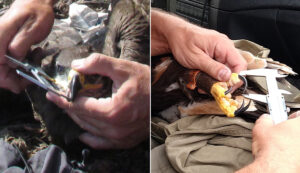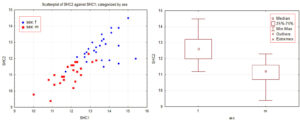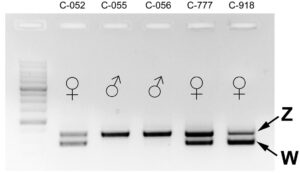Third International Scientific and Practical Conference “Eagles of the Palearctic: Study and Conservation”
Raptors Conservation. Suppl. 2. Proceedings of Conferences
MORPHOMETRIC FORMULA FOR FIELD DETERMINATION OF THE SEX OF STEPPE EAGLE (AQUILA NIPALENSIS) NESTLINGS IN ALTAI-SAYAN REGION
Andreyenkov O.V. (Institute of Molecular and Cellular Biology SB RAS, Novosibirsk, Russia)
Shalnova M.A. (Novosibirsk State University, Novosibirsk, Russia)
Karyakin I.V., Shnayder E.P. (Russian Raptor Research and Conservation Network; Sibecocenter LLC, Novosibirsk, Russia)
Contact:
Natalya Andreyenkova anata@mcb.nsc.ru
Maria Shalnova shalnovamasha@gmail.com
Igor Karyakin ikar_research@mail.ru
Elena Shnayder equ001@gmail.com
Recommended citation: Andreyenkova N.G, Shalnova M.A., Karyakin I.V., Shnayder E.P. Morphometric Formula for Field Determination of the Sex of Steppe Eagle (Aquila nipalensis) Nestlings in Altai-Sayan Region. – Raptors Conservation. 2023. S2: 273–276. DOI: 10.19074/1814-8654-2023-2-273-276 URL: http://rrrcn.ru/en/archives/35073
Rapid sex determination of Steppe Eagle (Aquila nipalensis) nestlings without laboratory diagnostics is necessary for a variety of tasks. When working directly on a nest, it is important to know the sex of nestlings during population monitoring, ringing and tagging with GPS transmitters. Sex determination is also necessary when working with sick and injured birds, in rehabilitation centers, which do not always have the opportunity and time for genetic analysis. Experienced ornithologists in most cases can quite accurately determine the sex of nestling by eye, but this does not always work, and not all researchers have sufficient experience.
The Steppe Eagle has a noticeable sexual dimorphism in size, which is well manifested even in 45-day-old nestlings. However, the size ranges of females and males overlap greatly, so one cannot reliably determine sex simply by measuring any one part of the bird's body.
We have developed morphometric discriminant formulas that allow us to determine with high accuracy the sex of a Steppe Eagle nestlings in Altai-Sayan region, using the size of the tarsus, claws, beak, and tail feathers. The formulas were obtained based on measurements of (n=52) 55–65-dayold nestlings (25 males and 27 females) born in 2019. The nestling sex was determined genetically by amplification of the CHD1 gene intron, which has different length in Z and W sex chromosomes of most bird species. We analyzed relationship between various morphometric characteristics of the nestling and its sex and obtained formulas that correctly determine the sex of 51 out of 52 nestlings in the initial sample and 32 out of 33 nestlings in the test sample (born in 2021).
Our discriminant formulas use both direct measurement values and ratios of different measurements to each other. In order to obtain the best formula, we altered the set of variables used and eventually chose several formulas that show the best results. These formulas can be used simultaneously to improve the accuracy of the determination. Despite the fact that the size of the tarsus, claws and beak in 55–65 day old nestlings is already quite stable, and the length of the feathers changes quickly, the formula obtained using the length of the tail gave better results than without using it.
Statistical analysis showed that females and males of the Steppe Eagle have the most significant differences in tarsus diameter: it is, on average, larger in females. Differences are already noticeable in 45-day-old nestlings, whose paws almost reach the size of those of an adult bird. Moreover, the longitudinal and transverse tarsus diameters weakly correlate with each other and even more weakly with the sizes of beak, claws, and feathers, but they correlate with sex more than other measurements. This is what makes it possible to determine the sex of nestlings in the nest with a fairly high accuracy. However, analysis of nestlings born in 2022, when the depression of pika population led to a severe shortage of food for the Steppe Eagles, shows that with severe underfeeding and a lack of subcutaneous fat, female tarsus turn out to be abnormally thin, and the formula often incorrectly identifies such nestlings as males. Therefore, we developed a separate formula for determining the sex of nestlings with obvious lack of mass, which in turn less accurately determines the sex of normal nestlings. Thus, when using morphometry to determine sex, it is necessary to take into account the body condition of the nestling.
The study was supported by the Basic Research Program FWGZ-2021-0014.

Measurement of the Steppe Eagle (Aquila nipalensis): width of the mouth – at the left, length of the hind talon – at the right. Photos by L. Zinevich and P. Mestri.

Fig. 1. Dependence of the longitudinal tarsus diameter (SHC2) on transverse tarsus diameter (SHC1) in steppe eagle nestlings (blue dots are females, red square are males) – at the left, and box plots of the distribution of longitudinal tarsus diameter in females and males nestlings of the steppe eagle (dots indicate the median values, whiskers are extreme 25% of values) – at the right.

Fig. 2. Sex determination of steppe eagles using PCR of the CHD1 gene intron. Males that carry two Z chromosomes produce one band, while females (Z and W chromosomes) produce two bands in gel electrophoresis.
